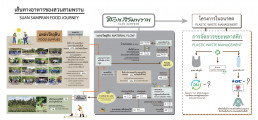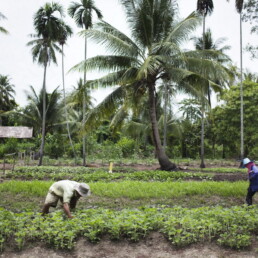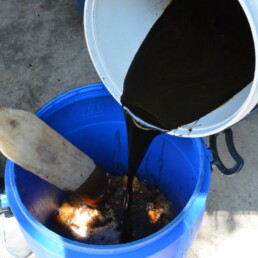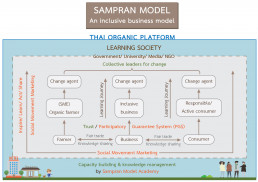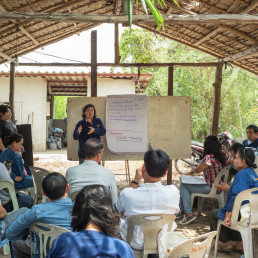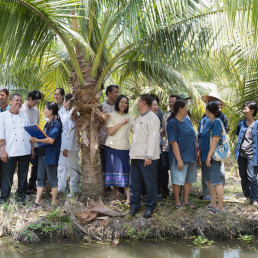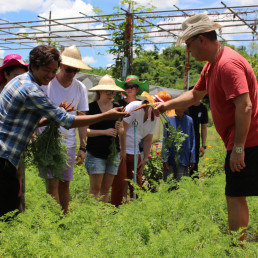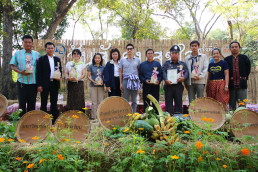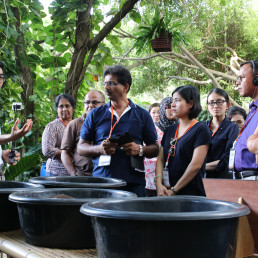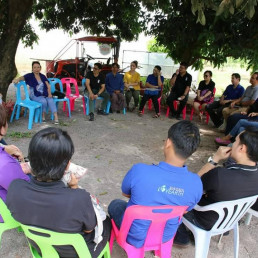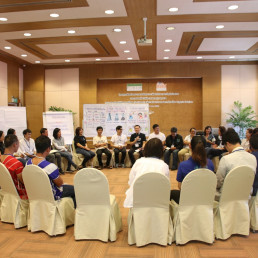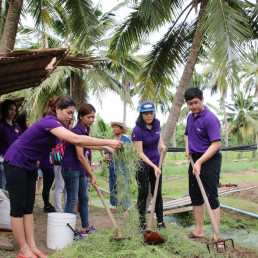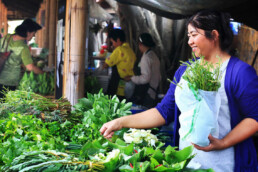Sustainability
Policy
Sustainability Policy
Fostering an organic society through partnership and fair trade. Suan Sampran is supporting groups of farmers to practice organic agriculture and become SMEs, helping to expand market channels by linking them with other businesses, while promoting consumers to take part in this social movement. Moreover, Suan Sampran’s business practices are embrace the concept of Circular Economy
Sustainability Practices
• 50 acres land of in Suan Sampran is certified organic according to IFOAM, EU and CANADA standards
• Established the Sookjai Foundation in 2014 to initiate the Sampran Model, an inclusive business model, to foster an organic society by supporting 16 groups of 170 farmers to practice organic agriculture and connect them with businesses and consumers
• Purchase organic produce from farmers in the Sampran Model network which amount to 70% of all food ingredients used
• Grow our own rice, vegetables, fruits, and herbs at Patom Organic Farm, yielding approximately 1-2 tonnes per month
• Allocate about an acre of land and building facilities for the Sookjai Farmers’ Market where organic farmers in the Sampran Model network can sell directly to consumers
• Ban use of foam packaging, plastic straws and plastic bottles
• Recycle all our food waste into organic fertiliser, animal and wormery feeds
• Produce organic foods and body care products under the “Patom” brand
• Recycling used vegetable oils into biodiesel for various uses in Suan Sampran
Food Journey and Circular Economy
Impact
- Health: Better health for farmers and consumers due to no chemical usage
- Economy:
- Suan Sampran has bought organic ingredients directly from farmers approximately 700,000 baht per month.
- Sookjai Famers’ Market has created revenues for organic farmers and communities approximately 3,000,000 baht per month.
- Environment:
- Carbon Footprint of food management in Suan Sampran is less than the general food management due to
- Direct transportation of organic ingredients from local farmers
- Organic produce mainly utilizes agricultural input from the area while conventional farming generally depends on imported chemicals.
- 100% food waste (approximately 4 tonnes per month) is being recycled
- More balanced ecosystem from no chemical usage in Suan Sampran’s gardens and farm
- Carbon Footprint of food management in Suan Sampran is less than the general food management due to
Society: Fair trade and collaborations between farmers, businesses, and consumers in the organic value chain
Sampran Model and Organic Tourism
From extensive experiences of practicing inclusive business following Sampran Model that has the mission to create learning society through partnership and fair trade, Suan Sampran has become an exemplary learning case for other businesses. Organic Tourism is an initiative to share such practices amongst network of hotels and restaurants who are interested in connecting with local organic farmers, engaging with their customers, and participating in the organic social movement.
Knowledge Sharing and Collaborations
With the aim to inspire learning and foster change, Suan Sampran is ready to share experiences gained from ongoing practices of inclusive business and driving the movement for sustainable food system. Moreover, Suan Sampran promotes collaborations with all stakeholders in various ways from CSR to R&D and business partnerships. Additionally, Sampran Model Academy, with the role to perform knowledge management, is offering a learning exchange platform on multiple topics such as Inclusive Business, Circular Economy, and Learning Organization.
Sookjai Market
Sookjai Farmers’ Market was established in 2010 to promote organic agriculture and serve as a channel to connect organic farmers in Sampran Model network with consumers. Thus people can gain access to trusted organic products at reasonable prices. Currently there are about 70 vendors selling rice, vegetables, fruits, freshly cooked foods, and processed foods with revenues generated for farmers and communities approximately 3,000,000 baht per month. Sookjai Farmers’ Market is being managed by a committee elected from the vendors annually. Moreover, there is a consumer committee who help share their demands and experiences with the vendor committee so they can help further improve market managment.
